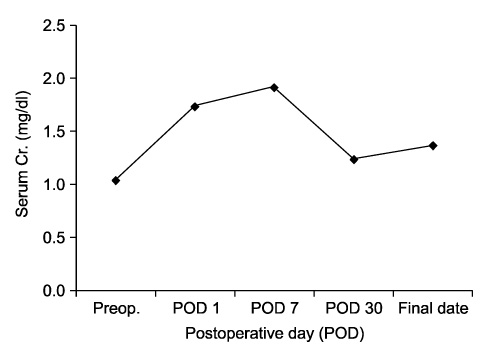Korean J Urol.
2009 May;50(5):463-467.
Laparoscopic Partial Nephrectomy in a Solitary Kidney
- Affiliations
-
- 1Department of Urology, Institute of Wonkwang Medical Science, Wonkwang University School of Medicine, Iksan, Korea. seraph@wonkwang.ac.kr
Abstract
-
PURPOSE: Nephron-sparing surgery for renal tumors in solitary kidneys has several technical difficulties and complications, including renal failure. We evaluated operative outcome and feasibility in patients with renal cell carcinoma in a solitary kidney treated with laparoscopic partial nephrectomy.
MATERIALS AND METHODS
Between September 2003 and September 2008, 59 patients with renal tumors underwent laparoscopic partial nephrectomy. Among them, 4 patients with a solitary kidney were enrolled in the study. The mean age of the 2 male and 2 female patients was 66.8 years old, and their mean body mass index was 24.7. The mean size of the tumor was 3.5 cm.
RESULTS
The mean operative time was 138.5 minutes, and estimated blood loss was 163.8 ml. In 2 patients, warm ischemic times were 25 and 55 minutes. Initiation of postoperative oral intake and ambulation were at 1.0 and 1.5 days. The mean hospital stay was 15.0 days. One patient had a complication of urinary leakage. Pathologic examination revealed renal cell carcinomas with negative surgical margins in all patients. The mean serum creatinine level of preoperative and postoperative day 1 was 1.04 and 1.73 mg/dl, respectively. One patient required temporary hemodialysis. At the mean follow-up of 21.3 months, there was no recurrence of tumors. The mean serum creatinine level at the final visit was 1.36 mg/dl.
CONCLUSIONS
Laparoscopic partial nephrectomy for renal tumors in solitary kidneys can be performed safely. Although it is a possible modality with excellent outcome, long-term follow-up for cancer control, along with advanced laparoscopic technique and experience, is necessary.
Keyword
MeSH Terms
Figure
Reference
-
1. Ono Y, Sahashi M, Yamada S, Ohshima S. Laparoscopic nephrectomy without morcellation for renal cell carcinoma: report of initial 2 cases. J Urol. 1993. 150:1222–1224.2. McDougall E, Clayman RV, Elashry OM. Laparoscopic radical nephrectomy for renal tumor: the Washington University experience. J Urol. 1996. 155:1180–1185.3. Ono Y, Kinukawa T, Hattori R, Gotoh M, Kamihira O, Ohshima S. The long-term outcome of laparoscopic radical nephrectomy for small renal cell carcinoma. J Urol. 2001. 165:1867–1870.4. McDougall EM, Clayman RV, Chandhoke PS, Kerbl K, Stone AM, Wick MR, et al. Laparoscopic partial nephrectomy in the pig model. J Urol. 1993. 149:1633–1636.5. Winfield HN, Donovan JF, Godet AS, Clayman RV. Laparoscopic partial nephrectomy: initial case report for benign disease. J Endourol. 1993. 7:521–526.6. Rassweiler JJ, Abbou C, Janetschek G, Jeschke K. Laparoscopic partial nephrectomy. The European experience. Urol Clin North Am. 2000. 27:721–736.7. Gill IS, Matin SF, Desai MM, Kaouk JH, Steinberg A, Mascha E, et al. Comparative analysis of laparoscopic versus open partial nephrectomy for renal tumors in 200 patients. J Urol. 2003. 170:64–68.8. Hong SH, Ryu KY, Yoo JS, Seo SI, Kim JC, Hwang TK. Laparoscopic partial nephrectomy for the 4cm or less renal tumors. Korean J Urol. 2006. 47:1256–1262.9. Seo IY, Bae BJ, Rim JS. Early experience of laparoscopic partial nephrectomy for renal tumor. Korean J Urol. 2007. 48:1–5.10. Bang JK, Song C, Hong B, Park H, Kim CS, Ahn H. The effectiveness of simultaneous renal artery-vein clamping during laparoscopic partial nephrectomy on the surgical outcome. Korean J Urol. 2007. 48:897–902.11. Kim KY, Kim DK, Woo SH, Kim ET, Lee SB. Laparoscopic partial nephrectomy: an useful method of decision making for determining the approach and surgical method based on the systematic classification of tumor location. Korean J Urol. 2008. 49:1067–1073.12. Ghavamian R, Cheville JC, Lohse CM, Weaver AL, Zincke H, Blute ML. Renal cell carcinoma in the solitary kidney: an analysis of complications and outcome after nephron sparing surgery. J Urol. 2002. 168:454–459.13. Fergany AF, Saad IR, Woo L, Novick AC. Open partial nephrectomy for tumor in a solitary kidney: experience with 400 cases. J Urol. 2006. 175:1630–1633.14. Turna B, Aron M, Gill IS. Expanding indications for laparoscopic partial nephrectomy. Urology. 2008. 72:481–487.15. Jeschke K, Peschel R, Wakonig J, Schellander L, Bartsch G, Henning K. Laparoscopic nephron-sparing surgery for renal tumors. Urology. 2001. 58:688–692.16. Bhayani SB, Allaf ME, Link RE, Rao P, Varkarakis JM, Jarrett TW, et al. Laparoscopic partial nephrectomy in patients with neoplasia in a solitary kidney. Urology. 2004. 64:35–37.17. Gill IS, Colombo JR Jr, Moinzadeh A, Finelli A, Ukimura O, Tucker K, et al. Laparoscopic partial nephrectomy in solitary kidney. J Urol. 2006. 175:454–458.18. Seo IY, Lee YH, Rim JS. Percutaneous fibrin glue injection for urine leakage in laparoscopic partial nephrectomy. J Endourol. 2008. 22:959–962.19. Jang YH, Ahn H, Kim CS. Renal function after partial nephrectomy for renal cell carcinoma in solitary kidney. Korean J Urol. 2007. 48:1213–1218.
- Full Text Links
- Actions
-
Cited
- CITED
-
- Close
- Share
- Similar articles
-
- Laparoscopic Partial Nephrectomy using a Microwave Tissue Coagulator for Small Renal Tumor
- Current Status of Partial Nephrectomy for Renal Mass
- Current Status of Laparoscopic Partial Nephrectomy
- Analysis of Surgical Results of Laparoscopic Partial Nephrectomy for Endophytic Renal Tumor
- Renal Function after Partial Nephrectomy for Renal Cell Carcinoma in Solitary Kidney



